Essential lead generation can be split into two types: inbound leads and outbound leads. While both methods have their place in marketing strategy, the last thing you ever want to do is spend countless hours and thousands of dollars on lead-generation strategies that don’t result in loyal customers.
On the surface, the steps to achieve inbound lead success are simple. Create content, speak on podcasts, do webinars, eventually rank on SERPS, and, finally, generate leads. However, there’s a lot more to understanding how to generate inbound leads.
Don’t worry—we’ll guide you through it. From the meaning of inbound leads and the differences between inbound and outbound leads to proven strategies for scoring high-quality leads, we can help you master B2B inbound lead generation.
Note: Want to get a head start on targeting the right audience? You can try Leadfeeder free for 14 days here to see which companies are visiting your site—and target others just like them.
What is an inbound lead?
An inbound lead is a prospect who initiates contact with your business. Various inbound marketing channels make potential customers aware of your products, and once these customers show interest, they become an inbound lead. Inbound leads are high-value as they are ready to enter the sales funnel as soon as you have a way to contact them.
There are three main types of inbound leads:
Marketing qualified leads (MQLs): These customers have visited your website or social media profile to sign up for a guide, promotion, or other resource.
Product qualified leads (PQLs): These customers have tried your product or services with a free trial or freemium version.
Sales qualified leads (SQLs): These customers have reached out to your sales team about pricing or product information.
Inbound prospects are particularly useful in B2B lead generation, where sales cycles are often longer. Leads that show interest in your product or service are much closer to buying than cold prospects and therefore can be converted in a shorter time.
The process of generating inbound leads
Now that we have an inbound leads definition, leads explore the process of generating inbound leads. How do you turn interested customers into sales revenue?
Attract
First, you need to use inbound marketing channels to make potential customers aware of your brand. This means making use of content marketing strategies we explore later.
Useful content, like how-to guides, YouTube videos, and other materials, can help put you on the radar at the start of a buyer’s journey. Prospects can find your helpful resources organically through search engines, social media, and other means.
Engage
Now that you have the attention of your prospects, it’s time to deepen the relationship. Gain contact details with sign-up forms and website visitor tracking software. Next, engage them with personalized email marketing and tailored sales consultations. At this stage, it’s all about showing how your product solves the customer’s pain points.
Close
During engagement, your team will have further qualified your leads. They’ll have matched them with an ideal customer profile (ICP) and assessed how likely they are to buy through lead scoring. This information will help your product experts and closers to convert your leads into loyal customers.
Delight
Don’t rest on your laurels once the deal is closed. You still need to delight your customers by going above and beyond with follow-ups, check-ins, and comprehensive product support. Service channels, such as 24/7 live support and video tutorials, all help ensure customer satisfaction.
Gain customer feedback through surveys about your products and stay in touch to create a strong customer relationship. Satisfied customers will also become passionate advocates of your brand, generating more inbound leads.
Inbound vs outbound leads: Understanding the differences
Let’s take a brief pause to make sure we understand the differences between inbound and outbound lead generation.
Inbound lead generation is when you attract leads to your sales funnel with strategies like content marketing, SEO, and social media.
Leads initiate contact with your business through these channels and enter your sales funnel naturally.
Methods of generating inbound leads include:
Signing up for a newsletter
Downloading a whitepaper
Filling out a questionnaire
Contacting a sales team for a product demo
Some of the benefits of inbound lead generation are:
Organic growth: Leads reach out to your company with existing, genuine interest.
Sustainable marketing: Channels are set up for repeatable use. For example, evergreen SEO content will continue to attract leads for years to come.
Builds trust: Inbound marketing avoids gimmicky, pushy tactics and promotes credibility.
Better ROI: Organic marketing channels cost much less than aggressive outbound channels.
Outbound lead generation, on the other hand, is inherently more disruptive than inbound lead generation as it aims to place sales/marketing messages in front of prospects.
Outbound leads are also known as “cold leads.” Unlike warm inbound leads, you are initiating interactions in hopes of turning a cold prospect into an interested one.
Channels for outbound sales and lead generation include:
B2B cold emails/calls
Trade shows and industry events
TV and radio ads
Direct mail
Print Ads
The benefits of outbound lead generation include:
Controlled messaging: Outbound marketing provides greater control over who you target and how you reach them.
Quicker results: Targeted outbound marketing can generate short-terms quickly.
Test new markets: Campaigns built around new markets can reveal what works well before you invest more resources.
Top strategies for B2B inbound lead generation
Sparkling content, polished videos, and fine-tuned search engine optimization are labor-intensive. Whether you rely on an in-house team or hire an outside agency, creating content and reaping the results from it will take time and can snowball into a budget-swallowing expense if you don’t opt for the right inbound lead generation strategies and tactics.
Our list of strategies proven to increase inbound leads and consistently fill your sales pipeline will help get you started on the right track.
1. Attract loyal leads with podcasts
Podcasts have a permanent presence in modern life. In fact, nearly half of podcast listeners below 50 listen to podcasts multiple times a week, making them a highly effective way to connect with buyers.
When Micahel Sacca wanted to interview high-performing business people, he launched Rocketship.fm.
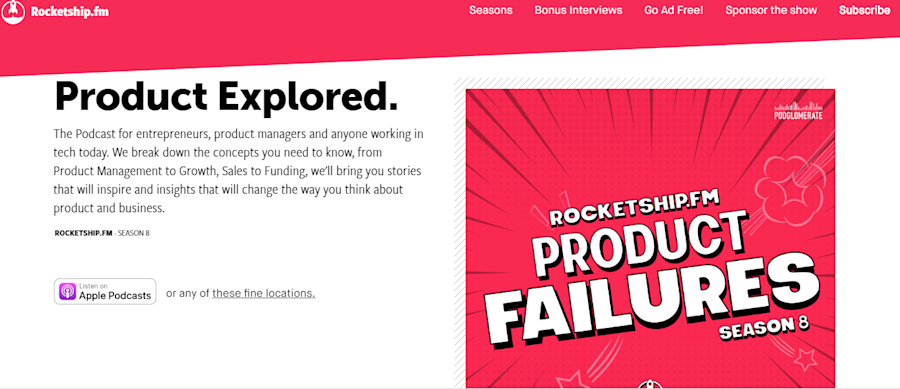
Busy with his marketing day job, he planned to record just three months of episodes and compile them later. But, the podcast struck a chord with listeners, and Rocketship.fm “took off”.
Today, it’s a thriving podcast for product managers and tech entrepreneurs that makes over $10k/month—not too shabby for something that started out as a side project.
If you’re strapped for resources, you don’t even need to launch your own podcast to increase inbound leads. Featuring your brand on other podcasts—through sponsorships or interviews—is just as effective.
This is because:
1. Podcasts are rising in popularity. From 2013-2019, the percentage of the population listening to podcasts has seen YOY growth.
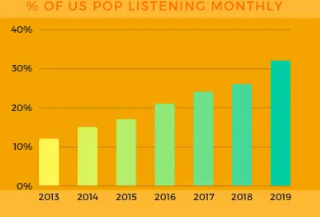
2. Podcasts introduce you to a wide audience. From the rich history of gnomes to true crime case reports, there’s a podcast for every niche imaginable. This means you have access to an array of buyers in multiple niches.
3. Podcast listeners are high-quality leads. 80% of listeners listen to all or most of each podcast episode. In other words, buyers are serious about their subject matter and have a high purchase intent.
2. Expand your inbound reach with Youtube
YouTube is the second-largest search engine in the world and a valuable platform for building inbound leads.
Keyword research tool Ahrefs, for instance, successfully ranks for extremely competitive search terms like “SEO tips” and “Local SEO” on YouTube.
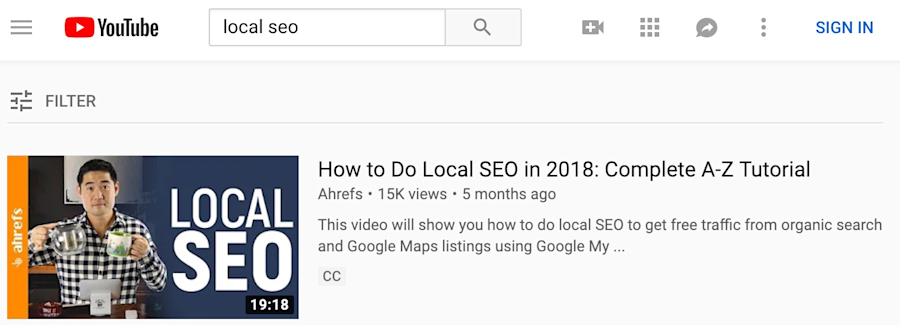
As with all inbound lead generation channels, content is king, however, Hollywood-level production how-tos aren’t necessary for each and every video.
Aside from instructional videos, you can also publish
Interviews with experts in your industry
Group panel discussions
Customer case studies
Light explainer videos
Product demos and reviews
The great thing is, with a little bit of YouTube SEO you can repurpose existing blog posts, checklists, and Q&As into magnetic content that attracts inbound leads.
3. Bolster B2B blog traffic with laser-focused content
After a two-year content production sprint, ClearVoice’s traffic and inbound lead generation hit a painful six-month plateau, and any attempts to revive dying traffic yielded little to no results.
Despite a repertoire of successful whitepapers, ebooks, and resources to increase inbound leads, organic traffic wasn’t moving past the 3k/month mark.
After creating unique B2B blog posts, however, organic traffic jumped from 2,900 to 51,500 sustainable monthly pageviews.
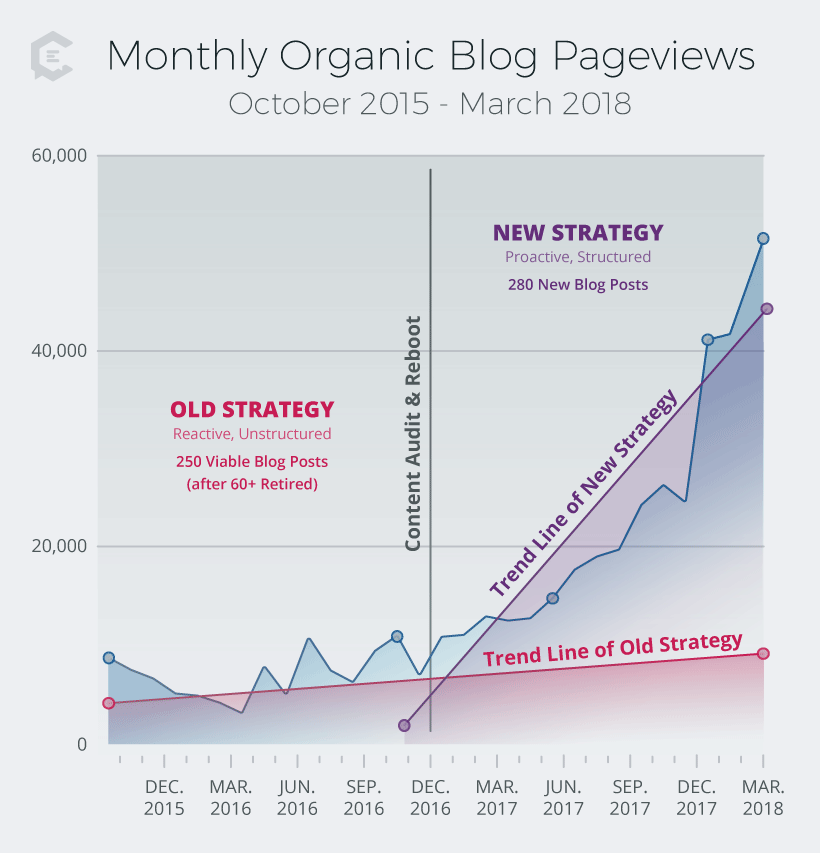
In a more dramatic example, B2B blogging rescued Groove from impending startup death when its fluff-filled content failed.
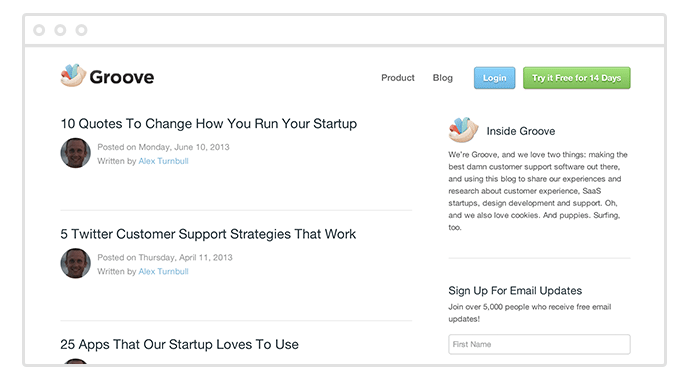
With no other options left to save his sinking startup, founder Alex Turnball went all-in on transparent content marketing. And, it had an immediate impact:
1,000 people subscribed to their email list in 24 hours.
Eventually, this small turnaround triggered a chain of events that turned Groove into the $5 million SaaS company it is today.
90% of published blog posts fail to generate a single backlink or even a trickle of traffic.
Content marketing is competitive, and there are more losers than winners.
The companies who win share content that leads with the needs of the customer.
Look around; the B2B companies who are killing it with content right now all have a unique angle that’s valuable to their buyers:
DataBox shines at interviewing experts for long-form heavy-hitting posts.
ClearVoice uses surveys and data to publish original research for its freelancers.
G2 specializes in extensive expert rounds ups for companies who use SaaS products.
If you’re serious about increasing inbound leads, stick a fork in the idea of generic listicles and how-tos. They’re already smothering the internet and they repel leads.
Instead, carve out a content strategy that revolves around unique content your buyers will love.
4. Fortify off-page SEO with guest posting
Guest blogging is the secret behind co-founder Leo Widrich propelling SaaS company Buffer from an obscure startup to a $5 million app.
For nine months straight, Leo became a one-man guest posting machine and published 150 posts.
Hard work? Yes. Worth it? Definitely.
This intensive period of writing for other sites catapulted Buffer from an unknown app to its first 100,000 users.
But, isn’t guest blogging to increase inbound traffic and leads a dead practice nowadays?
Yes and no.
The days of guest posting with the intention of driving thousands of visitors to your site are long gone. However, it’s still a useful method for generating backlinks that improve SEO and increase inbound leads.
A survey by SEMrush reveals that despite its turbulent past, guest posting still reigns as the number one link building strategy that SEOs recommend.

Inbound marketing pros like Hubspot, Ahrefs, and Neil Patel still use guest posting to increase inbound leads to this day.
“I’ve tried many different inbound marketing strategies, but guest blogging has remained my most treasured tool. QuickSprout wouldn’t have been as successful as it’s become if I’d neglected guest blogging.” — Neil Patel, QuickSprout Founder
Aside from earning high-quality backlinks, guest posting also unlocks doors for profitable content partnerships and introduces you to new customers.
5. Use email lists: the ultimate tool for increasing inbound leads
Every $1 spent on email marketing nets an average return of $42.
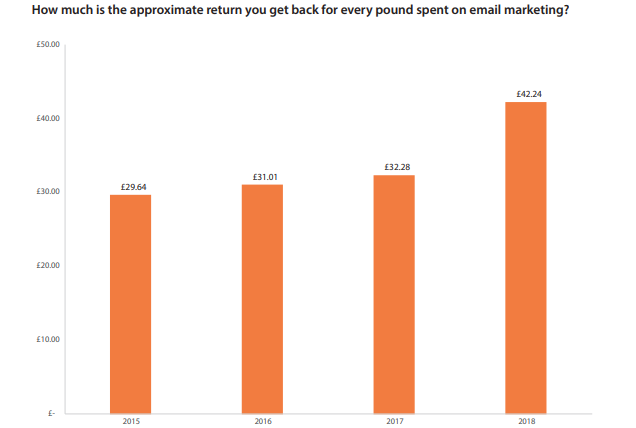
Just like being told to “eat your greens” for the umpteenth time, “the money is in the list” is a vital marketing truism that’s often overlooked.
Tying all your efforts to the growth of your email list is the ultimate way to attract, retain, and increase inbound leads. To accelerate the growth of your email list:
Add CTAs to all your content
Split test different opt-in forms across your website
Use gated content like whitepapers, reports, and case studies for technical hot topics
Once you’ve grown that list, you open the doors to responsive inbound leads that fill your sales funnel with high-quality prospects.
A sizable list will also synergize your overall inbound lead generation strategy.
Because, within a few clicks, you instantly have thousands of eyeballs on a new piece of content, savvy buyers to survey, and sales-ready leads.
The next step: inbound lead qualification
Inbound marketing naturally starts the qualification process, as those who enter your sales funnel this way have already shown some interest. However, you still need to work out how much they are interested in buying your product.
Sure, you’re gaining leads who found you on their own, but that doesn’t mean every inbound lead is created equal. You will still want to maximize resource use and ROI by focusing on the customers most ready to make a purchase.
Qualifying inbound leads helps optimize your sales process by guiding your team to the prospects most likely to buy.
Here are the basic steps of inbound lead qualification:
Develop ICPs: Create specific, detailed profiles of your perfect customers. ICPs should guide all of your inbound sales and marketing efforts.
Gather lead information: Use lead generation software to enrich prospect data with company details.
Lead scoring: Use a system to rate each prospect according to pre-set criteria. Scoring can be based on details such as demographics, budget, and customer behavior.
Segmentation: Break prospects down into categories, prioritizing those most likely to convert.
Outreach and nurturing: Engage your leads further with the expertise of your sales team.
Close the sale: Pass qualified leads on to team members who can close the deal and ensure a purchase.
ROI Amplified: An inbound lead generation strategy success story
ROI Amplified, a PPC agency based in Tampa, Florida, had attempted to increase inbound leads by strengthening its content marketing. However, despite healthy-looking metrics, the strategy wasn’t working.
It turned out that while traffic, clicks, and page views were rising, visitors were failing to leave any contact information further along the funnel.
CEO Zach Bowlby used a Zapier integration to connect Leadfeeder to Sharpspring and investigate the issue. He discovered that the marketing focus on technical content was mostly attracting students and academics rather than potential clients wanting to hire the agency.
Thanks to this richer information, ROI Amplified was able to optimize its strategy. With Leadfeeder, the company altered its tactics to fit its ICP, focusing on top-level content for marketers and immediately generating more qualified inbound leads.
“Leadfeeder has been really good for figuring out what content is reaching who.” - Zach Bowlby
Increase inbound leads with Leadfeeder by Dealfront
Inbound lead generation demands unique content that cuts through the noise, fine-tuned SEO, and a multichannel approach to lead generation. However, successfully generating inbound leads requires investment and the last thing you want is to burn thousands of dollars on tactics that don’t work.
With the proven inbound lead generation strategies above, you don’t have to worry about following redundant practices that waste your budget and fail to bear fruit.
Leadfeeder by Dealfront streamlines the inbound lead generation process by identifying your anonymous website traffic. When combined with Dealfront’s GDPR-compliant, B2B contact database, you can enjoy data-enriched, high-quality inbound leads straight from your website.
Sign up for a free 14-day trial and discover how Leadfeeder can increase targetable inbound leads for you today.
Note: Want to get a head start on targeting the right audience? You can try Leadfeeder free for 14 days here to see what companies visit your site—and target others just like them.
Inbound leads FAQs
What are the different types of inbound leads?
The three main types of inbound leads are marketing qualified leads (MQLs), sales qualified leads (SQLs), and product qualified leads (PQLs).
MQLs show interest by engaging with organic marketing materials, SQLs reach out to sales teams, and PQLs engage with products by using free trials or freemium versions of products.
Why are inbound leads considered more valuable?
Inbound leads enter the funnel having already shown an interest in your product. This means they need less convincing than other leads and are more likely to convert into paying customers. Inbound leads are also more valuable because they come from sustainable channels like organic search traffic.
Inbound marketing costs are also considerably lower than outbound marketing costs, resulting in better ROI from optimized inbound marketing strategies.
How to create inbound leads
Creating inbound leads involves generating interest from organic channels such as content marketing, social media channels, and search traffic.
Content marketing can include blog posts, guides, how-to videos, and other formats that focus on the specific needs of your audience.
Sharing relevant content across social media channels creates engagement with your followers and potential customers.
Search traffic can be increased using search engine optimization (SEO) and website content personalized with keywords relevant to your target audience.
How to qualify inbound leads
Here’s how to qualify inbound leads:
Develop your ideal customer profile (ICP).
Gather lead demographics and other details.
Score leads according to information such as company size, industry, budget, need, and other criteria.
Segment and prioritize leads based on those most likely to buy.
Reach out and engage with prospects to further qualify and convert.
More leads, no forms.
Sounds too good to be true? It’s not. Identify companies already visiting your website and turn them into qualified leads to fuel your sales pipeline.
Show me how







